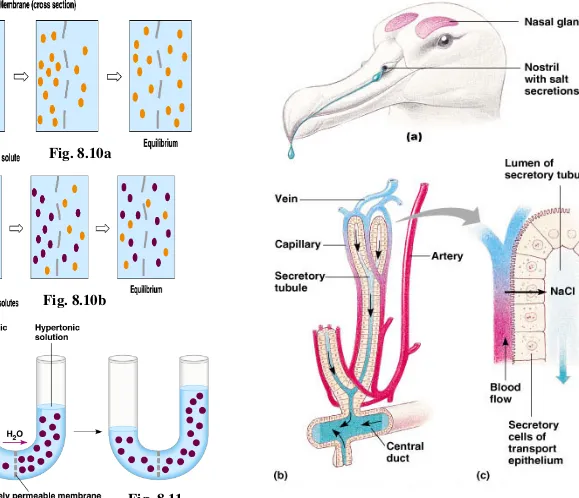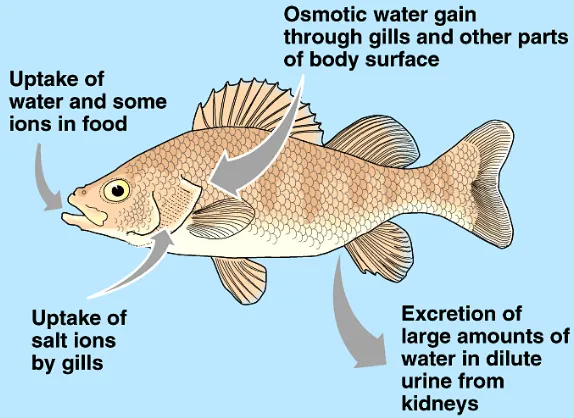CHAPTER 44
REGULATING THE INTERNAL
ENVIRONMENT
Copyright © 2002 Pearson Education, Inc., publishing as Benjamin Cummings
Section C: Water Balance and Waste Disposal
1. Water balance and waste disposal depend on transport epithelia
2. An animal’s nitrogenous wastes are correlated with its phylogeny and habitat
3. Cells require a balance between osmotic gain and loss of water
•
Animals must also regulate the chemical
composition of its body fluids by balancing the
uptake and loss of water and fluids.
•
Management of the body’s water content and
solute composition,
osmoregulation
, is largely
based on controlling movements of solutes
between internal fluids and the external
environment.
– This also regulates water movement, which follows solutes by osmosis.
– Animals must also remove metabolic waste products before they accumulate to harmful levels
.
•
While the ultimate goal of osmoregulation is to
maintain the composition of body’s cells, this is
primarily accomplished indirectly by managing the
composition of the internal body fluid that bathes
the cells.
– In insects and other organisms with an open circulatory system, this fluid is the hemolymph.
– Vertebrates and other animals with closed circulatory systems regulate the
interstitial fluid indirectly by controlling the
composition of blood.
•
In most animals, osmotic regulation and metabolic
waste disposal depend on the ability of a layer or
layers of
transport epithelium
to move specific
solutes in controlled amounts in particular
directions.
– Some transport epithelia directly face the outside
environment, while others line channels connected to the outside by an opening on the body surface.
– The cells of the epithelium are joined by impermeable tight junctions that form a barrier at the
tissue-environment barrier.
•
In most animals, transport epithelia are arranged
into complex tubular networks with extensive
surface area
.
– For example, the salt secreting glands of some marine birds, such as an albatross, secrete an excretory fluid that is much more salty than the ocean.
Fig. 44.12 Fig. 8.10a
Fig. 8.10b
•
The molecular structure of plasma membranes
determines the kinds and directions of solutes
that move across the transport epithelium
.
– For example, the salt-excreting glands of the albatross remove excess sodium chloride from the blood.
– By contrast, transport epithelia in the gills of freshwater fishes actively pump salts from the dilute water passing by the gill filaments.
– Transport epithelia in excretory organs often have the dual functions of maintaining water balance and
• Because most metabolic wastes must be dissolved in water when they are removed from the body, the type and quantity of waste products may have a large impact on water
balance.
– Nitrogenous breakdown products of proteins and nucleic acids are
among the most important wastes in terms of their effect on osmoregulation.
– During their breakdown, enzymes remove nitrogen in the form of
ammonia, a small and very toxic molecule.
• In general, the kinds of nitrogenous wastes excreted depend on an animal’s evolutionary history and habitat - especially water availability.
– The amount of nitrogenous waste produced is coupled to the energy
budget and depends on how much and what kind of food an animals eats.
•
Animals that excrete nitrogenous wastes as
ammonia need access to lots of water
.
– This is because ammonia is very soluble but can only be tolerated at very low concentrations.
– Therefore, ammonia excretion is most common in aquatic species.
– Many invertebrates release ammonia across the whole body surface.
– In fishes, most of the ammonia is lost as ammonium ions (NH4+) at the gill epithelium
.
• Freshwater fishes are able to exchange NH
4+ for Na+
from the environment, which helps maintain Na+
•
Ammonia excretion is much less suitable for land
animals and even many marine fishes and turtles.
– Because ammonia is so toxic, it can only be
transported and excreted in large volumes of very dilute solutions.
– Most terrestrial animals and many marine organisms (which tend to lose water to their environment by
osmosis) do not have access to sufficient water.
•
Instead, mammals, most adult amphibians, and
many marine fishes and turtles excrete mainly
urea
.
•
The main advantage of urea is its low toxicity,
about 100,000 times less than that of ammonia.
– Urea can be transported and stored safely at high concentrations.
– This reduces the amount of water needed for
nitrogen excretion when releasing a concentrated solution of urea rather than a dilute solution of
•
Land snails, insects, birds, and many reptiles
excrete
uric acid
as the main nitrogenous waste.
– Like urea, uric acid is relatively nontoxic.
– But unlike either ammonia or urea, uric acid is largely insoluble in water and can be excreted as a semisolid paste with very small water loss.
– While saving even more water than urea, it is even more energetically expensive to produce
.
•
Uric acid and urea represent different adaptations
for excreting nitrogenous wastes with minimal
•
Mode of reproduction appears to have been
important in choosing between these alternatives.
– Soluble wastes can diffuse out of a shell-less
amphibian egg (ammonia) or be carried away by the mother’s blood in a mammalian embryo (urea).
– However, the shelled eggs of birds and reptiles are not permeable to liquids, which means that soluble
nitrogenous wastes trapped within the egg could
accumulate to dangerous levels (even urea is toxic at very high concentrations).
•
Excretion of nitrogenous wastes is a good
illustration of how response to the environment
occurs on two levels.
– Over generations, evolution determines the limits of physiological responses for a species.
– During their lives individual organisms make
3. Cells require a balance between
osmotic gain and loss of water
• All animals face the same central problem of osmoregulation.
– Over time, the rates of water uptake and loss must balance.
– Animal cells - which lack cell walls - swell and burst if there is a
continuous net uptake of water or shrivel and die if there is a substantial net loss of water.
Water enters and leaves cells by osmosis, across a selectively permeable membrane.
Osmosis occurs whenever two solutions separated by a membrane differ in osmotic pressure, or osmolarity
•
There are two basic solutions to the problem of
balancing water gain with water loss.
• One - available only to marine animals which is to be isoosmotic to the surroundings as an osmoconformer
.
• Although they do not compensate for changes in
external osmolarity, osmoconformers often live in water that has a very stable composition and hence have a very constant internal osmolarity.
• Most marine invertebrates are osmoconformers, however the composition is different.
•
In contrast, an
osmoregulator
is an animal that
must control its internal osmolarity, because its
body fluids are not isoosmotic with the outside
environment
.
•
Whenever animals maintain an osmolarity
difference between the body and the external
environment, osmoregulation has an energy cost.
– Because diffusion tends to equalize concentrations in a system, osmoregulators must expend energy to
maintain the osmotic gradients via active transport and how much engery depends on concentration difference. – Osmoregulation accounts for nearly 5% of the resting
–
Marine fishes (class Osteichthys) constantly
loose water through their skin and gills.
– To balance this, these fishes obtain water in food and by drinking large amounts of
seawater and they
excrete ions by active transport out of the gills.
– They produce very little urine.
•
In contrast to marine organisms, freshwater
animals are constantly gaining water by
osmosis and losing salts by diffusion.
– Freshwater protists such as Amoeba and Paramecium have contractile vacuoles that pump out excess water. – Many freshwater animals,
including fishes, maintain water balance by excreting large amounts of very
dilute urine, regaining lost salts in food, and by active uptake of salts from their surroundings.
•
Salmon and other euryhaline fishes that migrate
between seawater and freshwater undergo
dramatic and rapid changes in osmoregulatory
status.
– While in the ocean, salmon osmoregulate like other marine fishes by drinking seawater and excreting excess salt from the gills.
– When they migrate to freshwater, salmon cease
drinking, begin to produce lots of dilute urine, and their gills start taking up salt from the dilute environment - just like fishes that spend their entire lives in
• The threat of desiccation is perhaps the largest regulatory problem confronting terrestrial plants and animals.
– Humans die if they lose about 12% of their body water.
• Adaptations that reduce water loss are key to survival on land.
– Most terrestrial animals have body coverings that help prevent
dehydration. These include waxy layers in insect exoskeletons, the shells of land snails, and the multiple layers of dead, keratinized skin cells. Also behavioral modifications so as to avoid dry conditions
• Despite these adaptations, most terrestrial animals lose considerable water from moist surfaces in their gas
exchange organs, in urine and feces, and across the skin.
– Land animals balance their water budgets by drinking and eating
moist foods and by using metabolic water from aerobic respiration.
– Some animals are so well adapted for minimizing water loss that




